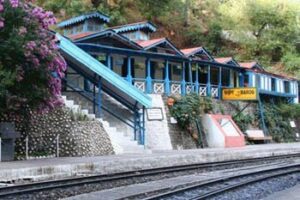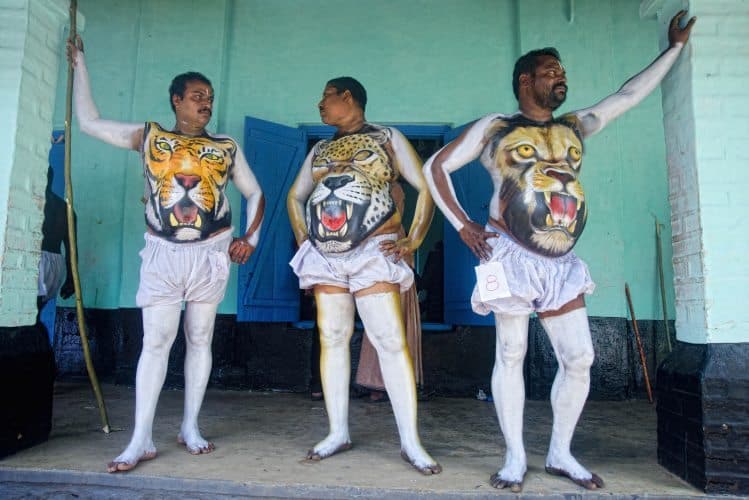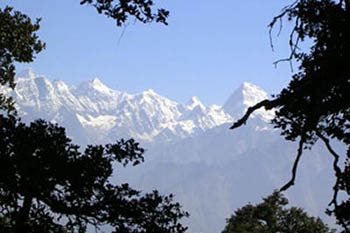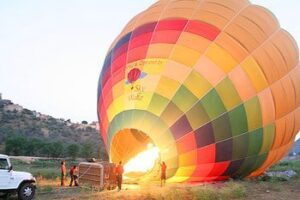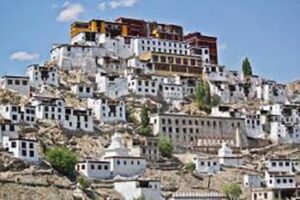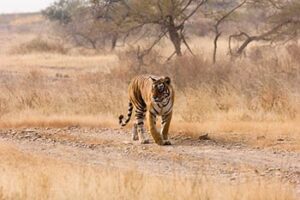
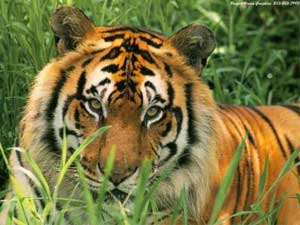
By Subhasish Chakraborty
It was the first week of May. The temperature was soaring in the vicinity of 104 degrees Fahrenheit (40°C).
We sat spellbound for around three hours at the Bicchubhog watchtower located inside Corbett National Park. We kept our cameras on the stand.
The atmosphere was serene and calm. We were waiting for that magical glimpse of the big cat. Across from the Bicchubhog watchtower, there was a small body of water. Suddenly we heard the alarm call from a group of monkeys in the trees nearby.
King of the Jungle
Soon enough we saw the king of the jungle striding authoritatively past the dense forest towards the water body, probably to quench his thirst and cool off from the sweltering heat.
We readied our cameras. The Tiger at first made an assessment of the surrounding environment and slowly ambled towards the water body and submerging half his body underwater, sat down in a relaxed position for some time.
Every time the camera clicked the big cat appeared to be slightly perturbed and stared ferociously at the watchtower where we were sitting. This continued for a good 20 minutes and at last, after cooling himself off in the water, the tiger slowly began to walk towards the jungle and vanished. My companion – Pranab Dhar was still enthralled, marveling at what he had seen only a few moments before.
Our primary goal of coming to Corbett National Park all the way from Calcutta via New Delhi was to take a few good pictures of wildlife in Corbett.
Visitors from the UK
Three days before at the Field Director’s office, we had met Tony and Leslie who had come all the way from the U.K. to appreciate Corbett’s wildlife. The Field Director informed us that Tony and Leslie became interested in visiting Corbett National Park after reading a few books written by the legendary Jim Corbett himself.

They wanted to know more about the Indian tiger and were hell-bent to have a glimpse of the big cat even if it involved roughing it out in the wild.
We were impressed by their concern for Indian wildlife and at the personal request of the Field Director, we decided to add them to our party.
We showed our entry documents, completed all other paperwork, and started moving towards Khinonawli Rest House. We were granted permission to stay at Khinonawli Rest House for the first three days and at Dhikala Rest House for the next four days.
History of the Corbett National Park
On 8th August 1936, Corbett became India’s first National Park. At that time Corbett National Park was named after the then United Province Governor – Sir Malcolm Hailey and the park was thereafter named Hailey National Park.
However, in 1954, the park was once again renamed as Ramnagar National Park. And finally in the year 1955, after the passing away of Jim Corbett in Kenya, the Park was finally named as Corbett National Park as a tribute to perhaps one of the world’s greatest Shikari and wildlife conservationists.
Corbett Park has an area of 203 square miles (525 sq. km). The park initially covered 125 square miles (324 sq. km), but it was felt the area was too small for species like the tiger and the elephant, which at times moved into the adjoining shooting blocks, which had suitable habitats, so they too were included. Now, of course, there are no shooting blocks. The only shooting allowed is with a camera.

In April 1973, the Government of India launched the ambitious ‘Project Tiger’ and out of the eight National Parks that were chosen to be a part of Project Tiger, the Corbett National Park was foremost on that list.
In 1974 due to the building of the Kalagarh Hydel Dam, a good 31 square miles (80 sq. km) of the reserved forest (plain grassland) went under the Ramganga Reservoir.
This grassland was home to elephants, cheetahs, deer, sambhar, hog deer, and tigers. Corbett National Park’s altitude varies between 385 meters to 1210 meters above sea level. The average temperature in summer is 108 degrees Fahrenheit (49°C) and the average winter temperature is 39 degrees Fahrenheit (4°C).
A lot of books have been written about Corbett National Park and its adjoining areas by famous naturalists. Jim Corbett’s “Man-Eaters of Kumaon and The Temple Tiger” (1958); Olive Smith’s “Tiger Lady” (1953); John Hewit’s “Jungle Travels In Northern India” (1938) are the most famous. Jim Corbett was the first to point out that tigers were disappearing in India and to symbolize the end of his hunting days, as it were, he buried his three rifles and two shotguns, before leaving for Kenya. In his letters to his friends, he wrote that his heart was still in India.
Khinanawli – Day Two
We departed for Kandha at the break of dawn. Kandha happens to be the highest point in Corbett National Park, situated at a height of 3,970 feet (1210 m) above sea level. The natural beauty of Kandha is mesmerizing. Our Gypsy crossed the Ramganga River and stopped at a place called Parh. Our driver Muhammed Nabi is a knowledgeable man and he knows Corbett like the back of his hand. Having parked the Gypsy by the banks of the Ramganga, he directed us to look into the waters where a giant crocodile was lazing off in the sun.
Our Gypsy started moving again towards Kandha. Each moment we traversed, the topography changed dramatically as we gained in altitude. All of a sudden our driver stopped the vehicle. He appeared to be listening to sounds emanating from the jungle from his window.
Relying on our past experiences of the jungle we could sense that a herd of wild elephants was grazing in the grasslands to the left of the road. Every now and then we heard the sound of tree branches being broken. Our driver – Nabi thought that it would be wise to take the vehicle towards the left of the road and accordingly he took a left turn and parked the vehicle where we could get a good view of the entire herd of elephants grazing.
The jungle here was less dense, so there was no obstruction. I began counting the number of elephants and there were 38 in all. There were six young ones and two were infants. The infants would play around and from time to time hurriedly
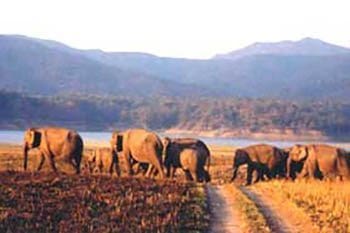
Sub-sonic Sounds
The spectacular sight of infant elephants blissfully playing around their mother reminded me of Scinthia Moss and Katherine Payne’s research work on elephant behavior.
They had concluded in their research work that elephants are perfectly capable of emitting and receiving sub-sonic sounds. Sub-sonic sounds are undetectable by human beings.
The sub-sonic sounds float in the environment for long distances and scientific research has come to the conclusion that elephants can comprehend sub-sonic sounds from a distance of 7 to 8 km (23 to 26 mi).
But, it is noteworthy that such meticulous scientific research with sub-sonic sounds and elephant behavior were carried out at Wamboseli National Park in Africa and they used African Elephants (Africana Loxodanta) as their experimental media. Experiments with sub-sonic sounds on Asian Elephants are yet to be carried out in India.
It was late afternoon by the time we reached Kandha Rest House. The Rest House is located in a sylvan setting. Since Kandha is the highest point of Corbett National Park, it provides spectacular panoramic views of the park. We climbed up the hillock and as the red molten ball dipped into the far horizon we wondered about the marvelous thing called creation.
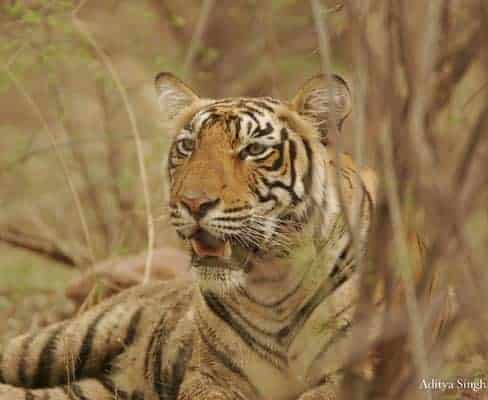 We started our return journey back to Khinanawli Rest House. Suddenly a huge tusker came out on the road from the left jungle. There was no way we could go forward. I and Nabi our driver instantly recognized that it was this very tusker which the Forest Department had warned us to be careful about.
We started our return journey back to Khinanawli Rest House. Suddenly a huge tusker came out on the road from the left jungle. There was no way we could go forward. I and Nabi our driver instantly recognized that it was this very tusker which the Forest Department had warned us to be careful about.
For the past month this tusker had been creating a nuisance by obstructing vehicles and attacking tourists. But Nabi was an expert driver and with a few deft turns, he brought the vehicle to a safe place.
From a distance, we could see the tusker throwing a huge amount of dust with his trunks and as we once again embarked on our vehicle we could hear the tusker trumpeting rather ferociously at us. He was angry. Wasn’t he? We reached Khinanawli Rest House and by now it was completely dark.
Dikhala – Last Day
In the months of April and May, elephant rides are very popular which originates from Dikhala. Accordingly, we embarked on an elephant safari that would take us to Poter Pani and Jamuna Gower jungle blocks.
As our elephant moved rhythmically over the grasslands, we saw a herd of spotted deer and the occassional sambhar. Once we hit the road to Jamuna Gower, I noticed that we were entering the sal forest. The advantage of traversing through sal forest is that there is very little undergrowth and one can view large tracts of the jungle without any obstruction.
The only sound that could be heard was of the elephant walking over the dried sal leaves that lay on the ground. We spotted a huge cluster of bamboo trees. Our mahout told us that there was a body of water just behind the bamboo trees and that a tigress with her three cubs was regularly spotted here. There was excitement in the air and I checked my camera for one last time.
Within minutes the tigress suddenly appeared before us, roaring rather furiously. Our elephant too made a weird sound by lifting its trunk in the direction of the tigress. The roar of the tiger and the elephant’s trumpet reverberated the entire jungle.
Our mahout shouted instructions to us that we should hold on to the iron bars of the howdah with full strength. I noticed that my foreign friends Tony and Leslie were frightened. Their bodies were shaking with fear and their faces turned pale.
All the while a spectacular wildlife drama was being enacted by the elephant and the tigress. It was a war of nerves. Neither of them would budge even an inch. I remembered those famous words of Kenneth Anderson: “While you are in the jungle, you have first got to win the war of nerves with the animals. Only then will you be safe.” And Anderson was dead right, for the ferocious tigress did retreat a few steps backward, unable to bear the elephant’s wild forays into its territory.
Our mahout told us that it would be dangerous to disturb the tigress any longer since she was actually protecting her three cubs just behind the bamboo trees.
We started our return journey to Dikhala and all the while the image of the angry tigress flashed back on me and I thought to myself that in this world of ours there is nothing like the tender loving bond that exists between a mother and child.
In the end, it would be apt to state that preserving tigers is a big task. It is very straining and nerve-wracking. One has to be constantly alert, hoping for a glimpse of the amber shadow. In Asian cultures the tiger is a magic symbol, epitomizing power, splendor, and ability.
Above all, the tiger symbolizes, perhaps more than any other animal, the need to protect at least a part of the natural world we share with other creatures of the wild.
A visit to Corbett will open your eyes to the conservation realities of our times.
Subhasish Chakraborty is an award-winning travel writer who has traveled extensively all over India and Nepal. He is based in West Bengal, India.
- Missouri Sports Travel Adventure: From Landmarks to Ballparks - January 21, 2026
- What First-Time Visitors Get Wrong About Visiting Iceland - January 15, 2026
- Bareboat Charter vs all-inclusive Crewed: Which Luxury Charter Fits You? - December 29, 2025



